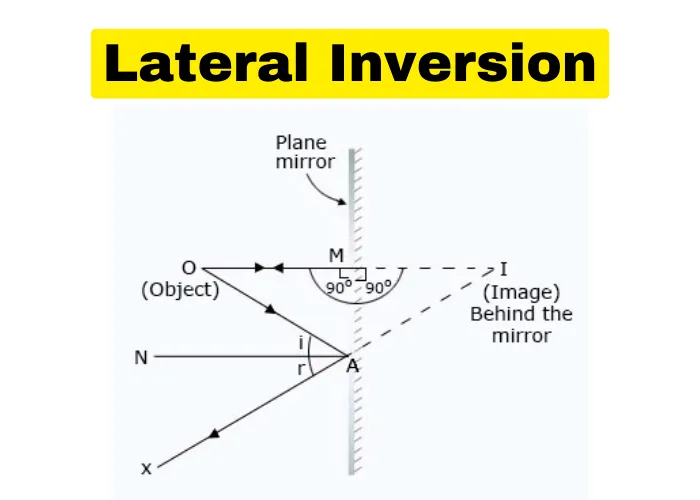Contents
Lateral inversion is a phenomenon where the image of an object appears reversed from left to right. In this article, we explore the science behind lateral inversion and its practical applications in fields such as optics and printing. We also discuss its relevance to perception and cognition, and provide examples to help illustrate the concept. Whether you’re a science enthusiast or simply curious about the world around you, this article offers a comprehensive introduction to lateral inversion.

Definition of Lateral Inversion
Lateral inversion refers to the reversal of images or objects in a horizontal plane. This phenomenon occurs when an object is reflected off a mirror or other reflective surface. In simple terms, the left side of the object appears on the right, and the right side appears on the left. Lateral inversion is also known as left-right inversion, horizontal inversion, or mirror reversal.
In scientific terms, lateral inversion is the reflection of light in a mirror, causing the image to appear reversed. Light travels in a straight line, and when it strikes a mirror, it is reflected back in the opposite direction, creating an image that is laterally inverted.
The term “lateral inversion” was coined by the English physicist James Clerk Maxwell in the mid-19th century. The term “inversion” refers to the fact that the image appears to be turned upside down, while “lateral” refers to the left-right reversal.
Examples of Lateral Inversion
The most common example of lateral inversion is the reflection of an object in a plane mirror. When you look at yourself in the mirror, the image you see is a laterally inverted version of yourself. Your left arm appears on the right side of the mirror, and your right arm appears on the left side.
Another example of lateral inversion is the reflection of text in a mirror. When you write a word on a piece of paper and hold it up to a mirror, the text appears reversed. This is because the light reflecting off the paper is laterally inverted in the mirror, causing the image to appear reversed.
Lateral inversion can also be seen in nature. For example, the way we perceive the movement of objects in a body of water is laterally inverted. When we watch a boat moving in the water, the left side of the boat appears on the right side of the water, and the right side of the boat appears on the left side of the water.
Science behind Lateral Inversion
Lateral inversion is a result of the way that light behaves when it strikes a mirror. Light travels in a straight line, and when it hits a mirror, it bounces back in the opposite direction. The angle of incidence (the angle at which the light hits the mirror) is equal to the angle of reflection (the angle at which the light bounces off the mirror).
When an object is placed in front of a mirror, the light reflecting off the object strikes the mirror and is reflected back in the opposite direction. This creates an image that is laterally inverted. The distance between the object and the mirror, as well as the angle at which the light strikes the mirror, affects the size and orientation of the image.
The physics behind lateral inversion is closely related to the concept of reflection. Reflection occurs when light bounces off a surface, and the angle of incidence is equal to the angle of reflection. The laws of reflection state that the incident ray, the reflected ray, and the normal (an imaginary line perpendicular to the surface) all lie in the same plane.
Importance of Lateral Inversion
Lateral inversion is an essential concept in our daily lives, and it has many practical applications. Here are some of the ways that lateral inversion is significant:
- Human Perception: Lateral inversion plays a significant role in human perception. When we look at ourselves in the mirror, we see a laterally inverted image of ourselves. This is because our brains have learned to perceive the image as normal, even though it is reversed. Our brains adjust to the reversal, so we see the image as if we were looking at ourselves from the front.
- Design and Engineering: Lateral inversion is an important concept in design and engineering. When designing a building or a machine, engineers and architects need to consider the way that the object will be perceived by the viewer. This includes how the object will appear in a mirror or other reflective surface. By understanding lateral inversion, designers can create objects that are visually pleasing and functional.
- Optics and Astronomy: Lateral inversion is an essential concept in optics and astronomy. Telescopes and other optical instruments use mirrors to reflect light, and understanding the way that light behaves when it is reflected is crucial for the design of these instruments. Lateral inversion is also important for understanding the behavior of light in the universe, including the way that light is reflected off planets, stars, and other celestial objects.
- Art and Photography: Lateral inversion is used in art and photography to create mirror images and other visual effects. Artists and photographers use mirrors to create symmetrical compositions or to distort images. By understanding the principles of lateral inversion, artists can create unique and compelling works of art.
- Computer Graphics and Animation: Lateral inversion is an important concept in computer graphics and animation. When creating 3D models or animations, designers need to consider the way that objects will be reflected in mirrors or other reflective surfaces. By understanding lateral inversion, designers can create realistic and accurate renderings of objects and environments.
Conclusion
Lateral inversion is a fascinating phenomenon that has intrigued people for centuries. It is the reversal of images or objects in a horizontal plane, caused by the reflection of light in a mirror or other reflective surface. Lateral inversion is an essential concept in physics, optics, and astronomy, and it has many practical applications in our daily lives, including design, engineering, art, and photography. By understanding the science behind lateral inversion, we can appreciate the complexity and beauty of the world around us.
FAQs
What is Lateral Inversion?
Lateral inversion is a phenomenon where the image of an object appears reversed from left to right.
How does Lateral Inversion work?
Lateral inversion occurs when the light rays from an object reflect off a surface and then reach our eyes. The image that we perceive is flipped horizontally, causing left to become right and vice versa.
Where can Lateral Inversion be observed?
Lateral inversion can be observed in a variety of contexts, such as in mirrors, lenses, and even in some optical illusions.
Can Lateral Inversion be corrected?
Yes, lateral inversion can be corrected using optical systems such as mirrors or lenses. Additionally, some computer programs and image editing software can reverse the lateral inversion effect.
Who discovered Lateral Inversion?
Lateral inversion was first described by Leonardo da Vinci in the 16th century, although it was not fully understood until the 19th century by scientists such as James Clerk Maxwell and Hermann von Helmholtz.



![Zoology Important Questions [Class 11th-English medium] Zoology Important Questions class 10 english medium](https://edukar.in/wp-content/uploads/2022/09/Zoology-Important-Questions-class-10-english-medium-1024x597.webp)
![Digital Documentation Class 9 [Questions Answers & MCQ] Digital Documentation Class 9](https://edukar.in/wp-content/uploads/2022/08/Digital-Documentation-Class-9-1024x597.webp)
![Corporate Accounting [Important Questions & Answers with MCQ] Corporate Accounting Important Questions & Answers](https://edukar.in/wp-content/uploads/2022/09/Corporate-Accounting-Important-Questions-Answers-1024x597.webp)
![Web application and Security Class 10 [Questions Answers & MCQs] Web application Class 10 Questions & Answers](https://edukar.in/wp-content/uploads/2022/09/Web-application-Class-10-Questions-Answers-1024x597.webp)





![Biology Class 10 Very important [Questions &Answers] Biology Important Questions with Answers class 10](https://edukar.in/wp-content/uploads/2022/09/Biology-Important-Questions-with-Answers-class-10-1024x597.webp)


